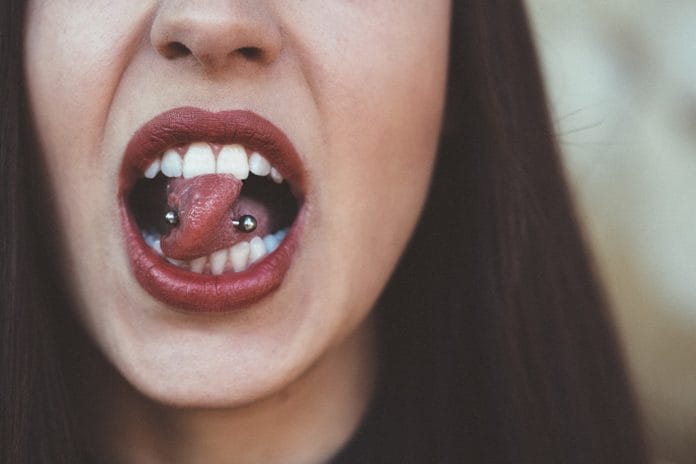It is no surprise that oral piercings cause damage to your teeth and gingiva, but people continue to support the practice and actively seek out these particular piercings every day. Oral piercings, such as a tongue ring, were once thought a fad but have overstayed their welcome when it comes to our hygiene and dental structure. Piercing and Oral Health: A Study on the Knowledge of Risks and Complications by Francesco Covello, Camilla Salerno, et al. studies the damage already done on current wearers’ teeth and the complications they will face in the future.
Kids Today
All over the world, teenagers and young adults make choices without looking toward the future. The entire definition of being young is based upon that attribute. The young see these piercings as rights of passage and as a connection to the other members of their chosen tribe. Unfortunately, many decisions these kids make have lasting and sometimes negative consequences. Intraoral piercings are just one of those decisions.
Far too many times these kids are pierced and sent on their way with only the knowledge on how to keep their piercing from getting infected, thus releasing any responsibility the parlor has towards the piercing itself. They aren’t taught how to maintain proper dental hygiene around what the body identifies as a foreign object. Their dental health suffers to the detriment of their or their parent’s wallets. This study was conducted to help prevent such detriments.
Purpose
The main purpose of the study is to formally verify and recognize the damage intraoral jewelry poses to the wearer and to give all dental professionals the base knowledge that they need to ideally encourage jewelry removal and at least teach damage prevention and modified hygiene practices. There is a widespread lack of awareness when it comes to maintaining oral piercings and the damage that they can do. Practitioners and hygienists are instrumental by trade in spreading such awareness and combatting further damaging and painful issues.
The Study
This study was conducted in central Italy, where the researchers went to several (tattoo) piercing establishments and a convention where they offered questionnaires to 387 individuals with oral piercings. Seventy of those individuals, mostly women, agreed to further visits from the research team to monitor their dental progression. Each of the seventy individuals was between the ages of eighteen and forty, and they were given anonymity on questionnaires.
General oral hygiene and the cleaning of the piercing sites were observed with just a mirror and the human eye. Tooth fractures, inflammation, infections, lesions, and increases in gingival recession were recorded. Individuals were responsible for any treatments they needed. More than half the 387 individuals who filled out questionnaires had received orthodontic treatment in their youth, and most were only moderate drinkers or smokers. The vast majority said that they brushed twice a day, but only eighty people reported regular flossing.
The Results
Thirty percent of the group said that the reason behind their piercing was self-expression, while almost half of the respondents got them simply because they looked cool. Looking cool is very important to kids, and young adults and convincing them to remove the damaging jewelry is very difficult. Convincing them of the prevalence of future damage is a process and will take time.
Only half the people questioned were briefly informed of any effects the piercings would have on their health, and half the people were never given information or warnings about any future issues. After the piercings healed, most of the individuals ceased to clean the area specifically, which exacerbates the decay and potential damage even further. Seventy percent of the group were never given any knowledge of gingival complications, and sixty percent were never informed about more serious complications, such as tooth fracture.
Only fifteen of the seventy people who agreed to further visits by the research team had sufficient oral hygiene. Ninety percent of the seventy people had gingival inflammation, and every person had a gingival recession. Many people had tongue lesions around their tongue rings and a direct thickening of the frenula around those specific piercings. A quarter of the seventy had obvious tooth fractures from clinking their tongue piercings against their teeth, and the breakage happened all over the mouth and not just in specific teeth.
Conclusions
Despite the increased interest in body modification, a majority of young folks are not given the guidance they require to avoid serious complications. There isn’t a dialogue between professional piercers and the dental community, so the practitioners may not even be aware of the extent of the damage such jewelry can cause. They aren’t in tune with the need to educate their client’s on how to clean the jewelry once the piercing has healed. Thus it becomes the responsibility of the dental staff to educate the young on the consequences of their decisions.
The researchers’ opinion is that dialogue must begin between the dental world and the world of body modification so that an individual’s education on the subject is complete and the damage is somewhat controlled. Until then, dental practitioners need to maintain a positive and trustworthy relationship with their patients so that they will continue their maintenance appointments while dental staff continues educating and monitoring for damage.
















